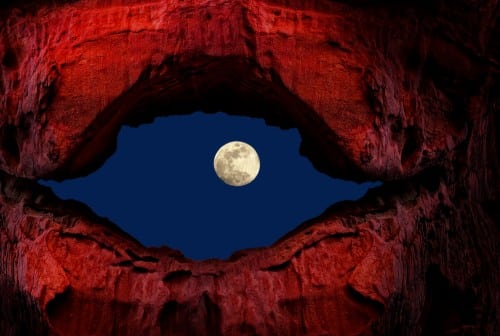A new series of measurements of oxygen isotopes provided confirmation that the Moon was formed as a result of the collision of the Earth with another large planet 4.5 billion years ago and that the materials on the Moon originated equally from both bodies

Scientists from Germany say they have found evidence that supports the theory that the moon was formed in a collision between the Earth and another celestial body. The researchers, from the University of Cologne, examined moon rocks collected by the astronauts in three Apollo spacecraft. According to them, the stones contain two different forms of oxygen atoms, one from the Earth and the other from the body that collided with it to form the moon.
In an article in the journal "Science", the researchers report that they have developed a chemical method to separate these two forms, and other materials in the moonstones. According to them, the findings show that the moon contains approximately 50% of each form, that is, it was composed in equal proportion from both bodies. The study strengthens the theory that a celestial body that scientists call "Theia" collided with the Earth only a few tens of millions of years after the beginning of its formation, and blew off a large piece of it, from which the moon was eventually formed.
The study was published in the journal Science at the same time as it was revealed at the Goldschmidt Geochemistry Conference to be held in California on June 11.
Most planetary scientists believe that the moon was formed as a result of a collision between the asteroid and another body the size of a planet, which was nicknamed Thea. The efforts to confirm the very existence of the collision centered on measuring the ratios between the isotopes of oxygen, titanium, nitrogen and other elements. These relationships vary from object to object in the solar system, but the close similarity between the Earth and the Moon from a chemical point of view conflicted with the theoretical models that included collisions indicating that the Moon was mostly torn from material provided by Theia, and therefore a different geochemistry than that of the Earth could be expected.
A group of researchers from Germany, led by Dr. Daniel Herwartz, used innovative and more accurate techniques to compare the ratio of oxygen isotopes 16 and 17 (17O/16O) from the lunar samples brought in the Apollo spacecraft with soil samples from Earth. The team initially used samples from the moon brought to Earth by meteorites, but because these samples changed their isotopes when they came into contact with water on Earth, fresher samples were needed. These were provided by NASA from Apollo missions 11,12, 16 and 17. They discovered that the rocks from the moon contain a greater ratio of 16O/XNUMXO than on Earth.
According to Dr. Herwartz "the differences are small and difficult to detect, but they exist. The word has two meanings. First we can be sure that a giant collision did occur. Second, the study gives us clues about the geochemistry of Thea. It seems that Theia belonged to what we call E-type chondrites. If this is true, we can now predict the geochemistry and isotopic ratios of the Moon, because today's Moon contains a mixture of Theia and early Earth. The next goal will be to find out how much of the material on the moon originates from Theia."
Most models estimate that the moon contains between 70% and 90% materials from Theia and the rest (10-30%) from the early Earth, however some of the models claim that only 8% of the Moon originates from Theia. According to Harwartz, the new data indicate a possible ratio of 50:50, but this still requires confirmation.
The team used advanced methods of preparing the samples before measuring with a mass spectrometer that checks isotope ratios, which showed a difference of 12 parts per million (plus or minus three parts per million) in the 17O/16O ratio between the Earth and the Moon.
The article is partly based on a news item by Itai Nebo published in Kol Israel news.

2 תגובות
Abraham
The term "probability" talks about the future. When you ask about the past, you should use the terms of Bayes' theorem, that is: you should attribute the event to a group of events. The moon's orbit is far from circular - the difference between the minimum distance and the maximum distance is about 10%. There are many possible routes for the lap, so the probability was not low at all. In addition, many bodies have collided with our poor planet, which increases the chance that something will go into orbit around us.
Let's look at it the other way around - something hit the planet and broke it in two. The two pieces moved away, then fell towards each other - the chance of them colliding again is low, so the chance of them going into a lap around each other is high.
1. According to the theory, what happened to the star Theia after the collision?
2. Is the probabilistic chance calculated that such a collision would put the moon into orbit around Earth?